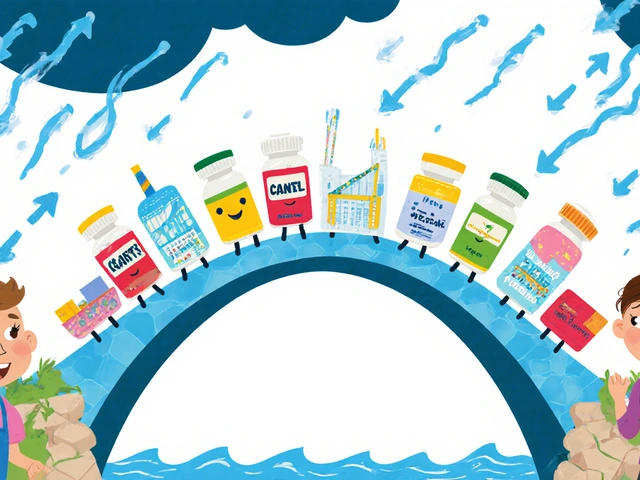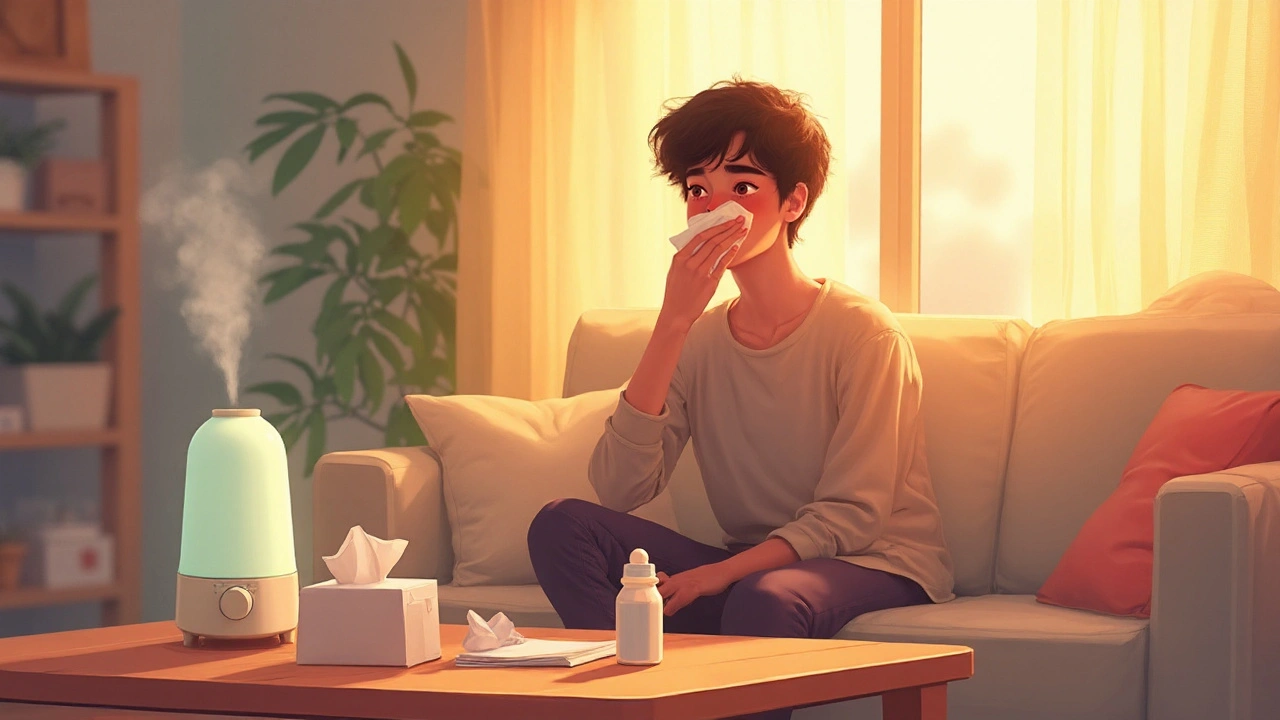Eye care is a collection of habits, products and medical actions designed to protect and sustain ocular health. When a blocked nose triggers red, watery eyes, neglecting proper eye care can turn a fleeting irritation into a chronic problem.
How a Stuffy Nose Triggers Eye Discomfort
The nose and eyes share a network called the nasal‑ocular reflex. When nasal passages swell-whether from a cold, allergies or sinusitis-the reflex signals the lacrimal glands to produce extra tears. This excessive tearing, combined with inflammation of the conjunctiva, creates the classic "red, watery eyes" picture.
Key Players in the Symptom Cycle
- Nasal congestion: swelling of nasal mucosa that blocks airflow and triggers reflex tearing.
- Conjunctivitis (often called pink eye): inflammation of the thin membrane covering the white of the eye and inner eyelid, leading to redness and discharge.
- Allergic rhinitis: an immune‑mediated response to airborne allergens that floods the nose with mucus and the eyes with histamine.
- Tear film: a three‑layered liquid coating that keeps the eye moist and clear; destabilised by excess mucus and inflammation.
- Lacrimal gland: the primary tear‑producing gland, over‑activated during nasal blockage.
- Sinusitis: infection or inflammation of the sinus cavities that aggravates both nasal and ocular symptoms.
- Dry eye syndrome: paradoxically, chronic tear over‑production can later lead to evaporative dryness.
- Antihistamine eye drops: topical medications that block histamine receptors in the eye, reducing redness and itching.
- Warm compress: a simple home remedy that loosens mucus in the nasolacrimal duct and soothes inflamed eyelids.
Quick‑Start Checklist for Immediate Relief
- Apply a warm compress to closed eyes for 5‑10 minutes, 3 times a day.
- Rinse eyes with sterile saline solution to flush out mucus.
- Use a nasal saline spray to clear the nasal passages without medication.
- Take an oral antihistamine if allergies are the likely trigger (e.g., cetirizine 10mg).
- Avoid rubbing eyes; instead, gently pat them dry with a clean tissue.
When to Choose Professional Eye Care Interventions
Most mild cases resolve within a week with home measures. Seek an optometrist or ophthalmologist if you notice any of the following:
- Vision blur that doesn’t improve after cleaning the eyes.
- Severe pain, swelling, or a sensation of a foreign body.
- Discharge that changes colour (yellow/green) suggesting infection.
- Persistent symptoms beyond 10 days despite self‑care.
Professional care may include prescription eye drops, culture tests, or referral to an ENT specialist for chronic sinus issues.

Comparing Common Treatment Options
| Option | Primary Mechanism | Typical Onset | Side‑effects |
|---|---|---|---|
| Warm compress | Improves tear drainage, reduces eyelid inflammation | Minutes | Rare; possible skin irritation if too hot |
| Antihistamine eye drops | Blocks histamine receptors in conjunctiva | 5‑10 minutes | Mild stinging, temporary blurred vision |
| Saline nasal spray | Physically clears mucus, reduces nasal‑ocular reflex | Immediately | None when used correctly |
| Oral decongestant (pseudoephedrine) | Constricts nasal blood vessels, eases congestion | 30‑45 minutes | Elevated blood pressure, insomnia |
Building a Long‑Term Eye‑Care Routine
Even after the nose clears, maintaining healthy eyes prevents flare‑ups. Incorporate these habits into daily life:
- Stay hydrated - at least 2L of water a day keeps tear film stable.
- Limit screen time or use the 20‑20‑20 rule (every 20min, look 20ft away for 20sec).
- Keep indoor air moist (humidifier set to 40‑50%). Dry indoor air worsens tear evaporation.
- Replace pillowcases weekly to reduce allergen buildup.
- Schedule annual eye exams; early detection of dry‑eye or allergic trends saves discomfort later.
Related Topics Worth Exploring
Understanding the link between nose and eyes opens doors to broader health conversations. You might also be interested in:
- Allergic rhinitis management - how environmental controls lower both nasal and ocular reactions.
- Sinusitis and eye pressure - when sinus infections push on the orbital cavity.
- Nutrition for ocular health - omega‑3 fatty acids and vitaminA support tear film resilience.
These subjects sit under the larger umbrella of respiratory‑ocular health, while the specific techniques in this article are a narrower focus on immediate eye‑care.
Next Steps for Readers
1. Try the warm‑compress routine for three days and note any change.
2. Add a saline nasal spray to morning and evening hygiene.
3. If symptoms linger, book an appointment with an eye professional and mention “blocked nose‑related conjunctivitis”.

Frequently Asked Questions
Why do my eyes water when my nose is stuffed?
The nasal‑ocular reflex senses congestion in the sinuses and tells the lacrimal gland to pump more tears, hoping to flush irritants out of the eye.
Can I use regular eye drops for this problem?
Plain lubricating drops help with dryness but won’t tackle the underlying histamine reaction. Antihistamine drops are a better match for allergy‑driven redness.
Is a warm compress safe for children?
Yes, as long as the temperature is comfortably warm (not hot) and a parent supervises the application for 5‑10 minutes.
When should I consider prescription medication?
If redness, pain, or blurred vision persists beyond ten days, or if discharge turns yellow/green, a doctor may prescribe antibiotic or steroid eye drops.
Do over‑the‑counter decongestants affect the eyes?
Systemic decongestants reduce nasal swelling, which can indirectly lessen reflex tearing. However, they may cause dry mouth and, in rare cases, raise intra‑ocular pressure for glaucoma patients.






10 Comments
When a nasal passage is blocked, the tear‑production reflex often over‑reacts, leading to watery, red eyes. Applying a warm compress three times daily can promote drainage and reduce inflammation. Rinsing the eyes with sterile saline helps clear mucus without irritating the conjunctiva. Using a saline nasal spray also eases the underlying congestion, which in turn calms the ocular response. Consistent hydration supports the tear film and prevents secondary dryness.
Blocking the nose triggers that reflex loop, so the eyes just end up over‑producing tears. A quick warm compress does the trick for most people, and it’s easy to do at home. Adding a saline spray for the nostrils helps break the cycle early. If symptoms linger past a week, a quick check‑up is wise. Otherwise, these simple steps usually keep things under control.
When your nose is clogged, your body sends a signal to the tear glands.
The signal makes the glands produce extra tears.
This is called the nasal‑ocular reflex.
The extra tears mix with mucus from the nose.
The mixture can make the eyes look red and watery.
A warm compress on the eyes helps the tears drain better.
You should use the compress for five to ten minutes.
Do it three times a day while the nose clears.
Rinsing the eyes with sterile saline removes any leftover mucus.
A saline spray in the nostrils clears the blockage directly.
Drinking plenty of water keeps the tear film stable.
Avoid rubbing your eyes because that can worsen irritation.
If you notice yellow or green discharge, it may be an infection.
In that case, see a doctor for possible prescription drops.
Most of the time, these home steps are enough to bring relief.
Keep a humidifier running at night.
Look, if you’re still crying over a runny nose after all that, you’re probably doing something wrong. The warm compress is only as good as the heat you apply-don’t use ice cold water, that just spikes the problem. Saline nasal spray works, but many cheap brands contain preservatives that can irritate the lining, so opt for a drug‑free version. Also, stop swiping at your phone for hours; screen fatigue makes your eyes dry and the tear film unstable. If the redness persists, a quick visit to an eye doc can rule out early conjunctivitis. Bottom line: follow the basics correctly, and you won’t need more than that.
It’s essential to remember that consistent hydration supports the mucous membranes, which in turn stabilises the tear film. Using a sterile saline rinse for both the eyes and nasal passages eliminates residual irritants without introducing chemicals. A warm compress applied for 5‑10 minutes, three times a day, promotes proper drainage of the nasolacrimal duct. Moreover, replacing pillowcases weekly reduces allergen buildup, a simple habit that can prevent recurring irritation 😊. Finally, schedule an annual eye exam to catch any underlying dry‑eye trends early.
Honestly, the article re‑hashes the same old advice you find on any generic health blog. The warm compress is touted like a miracle, yet it’s merely a modest heat application with negligible impact on chronic sinus issues. Saline spray, while safe, does nothing for the underlying allergic inflammation that fuels the reflex. If you’re truly seeking relief, you need a targeted antihistamine regimen, not this surface‑level checklist. In short, the piece reads like a filler exercise rather than a deep dive.
I see your point about the article’s lack of depth, but dismissing the simple measures altogether isn’t constructive. Warm compresses and saline rinses are low‑risk interventions that many patients find genuinely helpful. They’re not a replacement for prescription therapy, but they can reduce the need for stronger meds. A balanced approach that includes both basic care and medical treatment is what most clinicians recommend.
Look man the nose‑eye link is real and you can actually feel it when you’re stuffed up the eyes just start watering it's like a reflex that bodies have we all know it but most people ignore it so they keep rubbing their eyes and that just makes things worse a warm compress is cheap fast and works pretty well if you do it right also a saline spray can clear the nasal passage quickly dont overthink it just do the basics and you’ll see improvement fast enough
Oh wow, thank you for that groundbreaking revelation-who would have guessed that “basic” care works? It’s almost as if the medical community is conspiring to hide the secret of warm compresses from the public. Let’s all ignore the decades of ophthalmologic research and just slap a towel on our faces, shall we? At least it’ll make for a good meme.